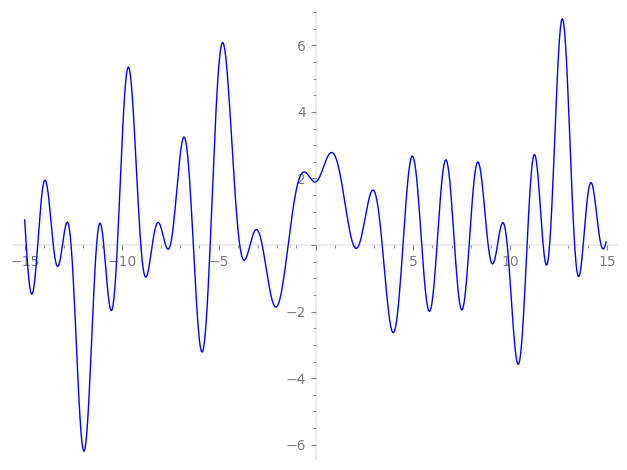| L(s) = 1 | + (1.16 − 0.183i)3-s + (0.587 + 0.809i)4-s + (0.156 − 0.987i)7-s + (0.363 − 0.118i)9-s + (−0.309 − 0.951i)11-s + (0.831 + 0.831i)12-s + (0.734 − 1.44i)13-s + (−0.309 + 0.951i)16-s + (0.280 + 0.550i)17-s − 1.17i·21-s + (−0.647 + 0.329i)27-s + (0.891 − 0.453i)28-s + (−1.53 + 1.11i)29-s + (−0.533 − 1.04i)33-s + (0.309 + 0.224i)36-s + ⋯ |
| L(s) = 1 | + (1.16 − 0.183i)3-s + (0.587 + 0.809i)4-s + (0.156 − 0.987i)7-s + (0.363 − 0.118i)9-s + (−0.309 − 0.951i)11-s + (0.831 + 0.831i)12-s + (0.734 − 1.44i)13-s + (−0.309 + 0.951i)16-s + (0.280 + 0.550i)17-s − 1.17i·21-s + (−0.647 + 0.329i)27-s + (0.891 − 0.453i)28-s + (−1.53 + 1.11i)29-s + (−0.533 − 1.04i)33-s + (0.309 + 0.224i)36-s + ⋯ |
\[\begin{aligned}\Lambda(s)=\mathstrut & 1925 ^{s/2} \, \Gamma_{\C}(s) \, L(s)\cr =\mathstrut & (0.978 + 0.208i)\, \overline{\Lambda}(1-s) \end{aligned}\]
\[\begin{aligned}\Lambda(s)=\mathstrut & 1925 ^{s/2} \, \Gamma_{\C}(s) \, L(s)\cr =\mathstrut & (0.978 + 0.208i)\, \overline{\Lambda}(1-s) \end{aligned}\]
Particular Values
| \(L(\frac{1}{2})\) |
\(\approx\) |
\(1.897202851\) |
| \(L(\frac12)\) |
\(\approx\) |
\(1.897202851\) |
| \(L(1)\) |
|
not available |
| \(L(1)\) |
|
not available |
\(L(s) = \displaystyle \prod_{p} F_p(p^{-s})^{-1} \)
| $p$ | $F_p(T)$ |
|---|
| bad | 5 | \( 1 \) |
| 7 | \( 1 + (-0.156 + 0.987i)T \) |
| 11 | \( 1 + (0.309 + 0.951i)T \) |
| good | 2 | \( 1 + (-0.587 - 0.809i)T^{2} \) |
| 3 | \( 1 + (-1.16 + 0.183i)T + (0.951 - 0.309i)T^{2} \) |
| 13 | \( 1 + (-0.734 + 1.44i)T + (-0.587 - 0.809i)T^{2} \) |
| 17 | \( 1 + (-0.280 - 0.550i)T + (-0.587 + 0.809i)T^{2} \) |
| 19 | \( 1 + (-0.309 - 0.951i)T^{2} \) |
| 23 | \( 1 + iT^{2} \) |
| 29 | \( 1 + (1.53 - 1.11i)T + (0.309 - 0.951i)T^{2} \) |
| 31 | \( 1 + (0.809 - 0.587i)T^{2} \) |
| 37 | \( 1 + (-0.951 - 0.309i)T^{2} \) |
| 41 | \( 1 + (0.309 + 0.951i)T^{2} \) |
| 43 | \( 1 - iT^{2} \) |
| 47 | \( 1 + (-0.297 - 1.87i)T + (-0.951 + 0.309i)T^{2} \) |
| 53 | \( 1 + (-0.587 - 0.809i)T^{2} \) |
| 59 | \( 1 + (0.309 - 0.951i)T^{2} \) |
| 61 | \( 1 + (-0.809 - 0.587i)T^{2} \) |
| 67 | \( 1 - iT^{2} \) |
| 71 | \( 1 + (0.5 - 1.53i)T + (-0.809 - 0.587i)T^{2} \) |
| 73 | \( 1 + (0.610 + 0.0966i)T + (0.951 + 0.309i)T^{2} \) |
| 79 | \( 1 + (-0.363 - 1.11i)T + (-0.809 + 0.587i)T^{2} \) |
| 83 | \( 1 + (-1.44 + 0.734i)T + (0.587 - 0.809i)T^{2} \) |
| 89 | \( 1 + T^{2} \) |
| 97 | \( 1 + (-0.863 + 1.69i)T + (-0.587 - 0.809i)T^{2} \) |
| show more | |
| show less | |
\(L(s) = \displaystyle\prod_p \ \prod_{j=1}^{2} (1 - \alpha_{j,p}\, p^{-s})^{-1}\)
Imaginary part of the first few zeros on the critical line
−9.017443715861773739854758864622, −8.428076123159130869218717001745, −7.74276262730874339510677640702, −7.49737671001327636076352551544, −6.31354374691960670681547488820, −5.44717324235561878876024836055, −3.92384761683630441541232026528, −3.39376568543135903939655598336, −2.76491654558222176374735511132, −1.43005586916215006319373486114,
1.93136434957506522467911336965, 2.21692622483491222058844665062, 3.41553740409049682800941933697, 4.48488835424899308263596296855, 5.45227399113869253560332919903, 6.23889608203218817186791074530, 7.14068651283221657079679632624, 7.892348425511757578957860005908, 8.873052170088508302341441634452, 9.351987838397067079096636722616

